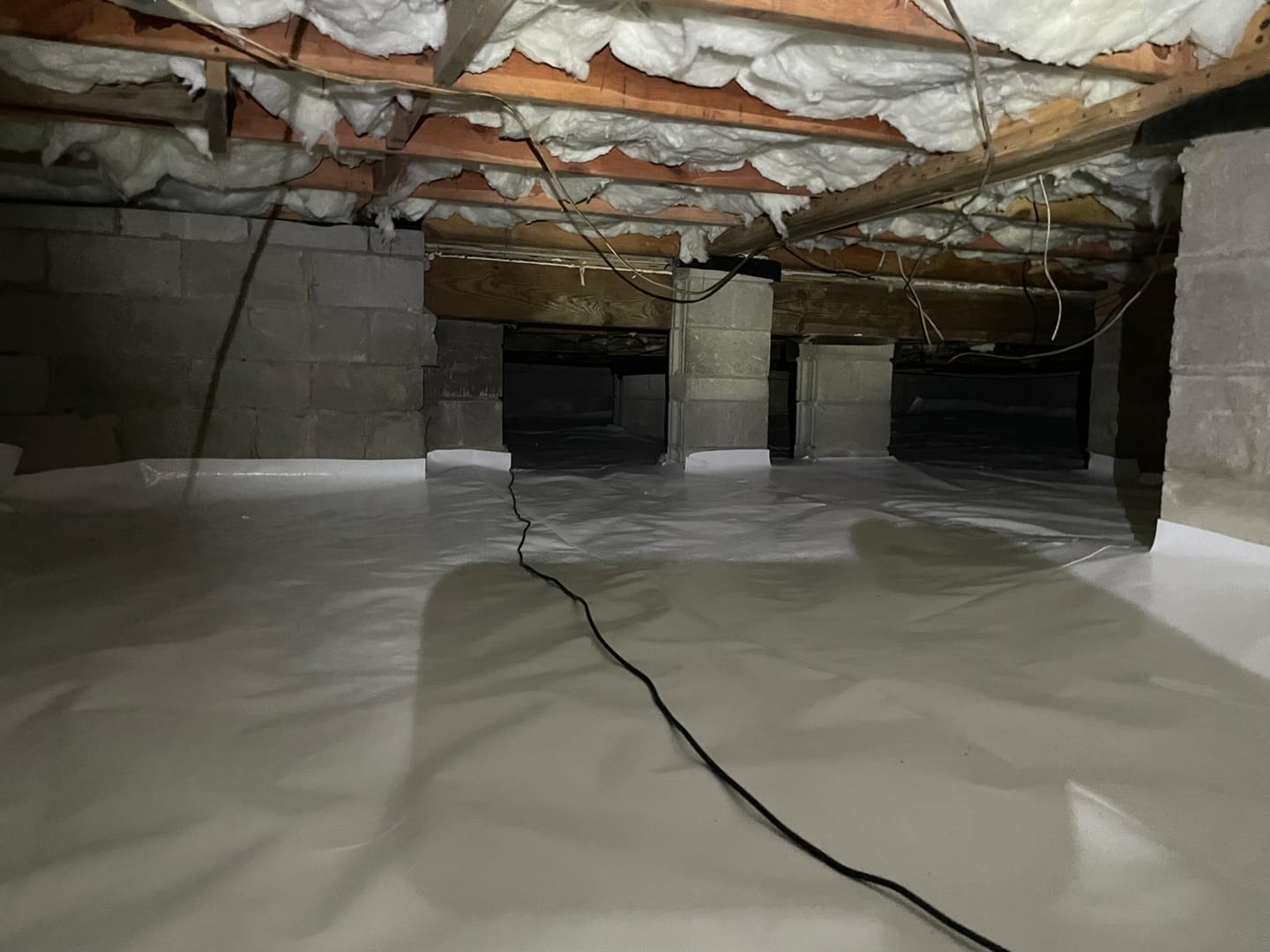Is your crawl space damp, musty, or downright wet? A wet crawl space can lead to all sorts of headaches, from skyrocketing energy bills to dangerous mold growth. But here’s the good news: you can fix it!
In this ultimate guide, we’ll dive into the world of wet crawl space repair. We’ll uncover the sneaky culprits behind the moisture, reveal the risks you can’t ignore, and show you the most effective ways to get your crawl space dry and healthy. Ready to take control of your crawl space? Let’s do this.
Causes of Water in a Crawl Space
If you’ve got a wet crawl space, you’re not alone. As a crawl space repair expert, I’ve seen my fair share of moisture problems. But before we can fix it, we need to understand what’s causing the water to get in there in the first place.
There are three main ways water can end up in your crawl space: below-grade sources, above-grade sources, and interior issues. Let’s dive into each one.
Below-Grade Water Sources
Common below-grade water sources that can lead to a wet crawl space include high water tables, underground springs, and poor soil drainage. As groundwater levels rise, hydrostatic pressure can force water through porous concrete or cracks in the foundation walls and floor.
I’ve seen this happen countless times, especially after heavy rains or when the snow melts in the spring. The water just has nowhere else to go, so it seeps into the crawl space and causes all sorts of problems.
Above-Grade Water Sources
Above-grade water sources that contribute to crawl space moisture problems are typically related to improper grading, clogged gutters, broken downspouts, and leaking HVAC units or plumbing. Overflowing gutters and downspouts that don’t divert water away from the foundation can saturate the soil and allow water to seep into the crawl space.
I once had a client who couldn’t figure out why their crawl space was always damp. Turns out, their gutters were clogged with leaves and debris, causing water to spill over the sides and pool around the foundation. Once we cleaned out the gutters and fixed the grading, their moisture problem disappeared.
Interior Water Issues
Interior water issues like leaking pipes, water heater failures, and washing machine overflows can introduce significant amounts of water into a crawl space. Homeowners should regularly inspect plumbing lines and appliances to catch small leaks before they turn into major moisture problems.
If a crawl space is constantly damp, it could be due to clogged gutters filled with leaves and debris causing water to overflow and gather around the foundation. By cleaning out the gutters and adjusting the grading, it is possible to resolve the moisture issue.
Problems Caused by a Wet Crawl Space
So, you’ve got a wet crawl space. What’s the big deal? Well, let me tell you, moisture in your crawl space can cause all sorts of problems throughout your entire home. And I’m not just talking about a little dampness here and there.
A wet crawl space can lead to higher energy bills, mold growth, poor air quality, and even structural damage. Let’s take a closer look at each of these issues.
Higher Energy Bills
Wet crawl spaces can lead to higher energy bills because the damp air takes more energy to heat or cool. The moisture can also degrade insulation, making the home less energy efficient. Some estimates suggest that wet crawl spaces can increase energy costs by up to 15-25%.
I’ve seen this firsthand with many of my clients. They couldn’t figure out why their energy bills were so high, even though they kept their thermostat at a reasonable temperature. Once we fixed their crawl space moisture problem, their energy costs dropped significantly.
Mold Growth and Poor Air Quality
Mold thrives in damp, humid environments with organic materials like wood, drywall, and insulation. In a wet crawl space, mold spores can easily spread through the home’s living areas, causing allergic reactions and respiratory issues. Studies have shown that up to 50% of the air in a home’s living space originates from the crawl space or basement.
Structural Damage
Prolonged exposure to moisture can cause serious structural damage to a home’s wooden framing, floor joists, and support beams. As the wood absorbs water, it can warp, rot, or become infested with wood-destroying insects like termites. Over time, this damage can compromise the integrity of the entire structure.
I’ve seen crawl spaces so badly damaged by moisture that the floors above were starting to sag and buckle. It’s not a pretty sight, and it can be incredibly expensive to repair. That’s why it’s so important to address crawl space moisture problems as soon as you notice them.
How to Keep Your Crawl Space Dry
Now that you know the dangers of a wet crawl space, you’re probably wondering what you can do to keep yours dry. Well, I’ve got some tips and tricks that I’ve learned over the years that can help.
The key is to attack the moisture problem from all angles – below, above, and inside. Here are some of the most effective ways to keep your crawl space dry:
Install a Vapor Barrier
Installing a heavy-duty vapor barrier, like a 20-mil polyethylene sheet, across the entire crawl space floor and up the foundation walls can effectively block moisture from the soil. The vapor barrier should be sealed at all seams and penetrations with tape or adhesive to create a continuous moisture barrier.
I always recommend using a high-quality vapor barrier for crawl space repair. Cheap, thin plastic just won’t cut it – it’ll tear easily and won’t provide the same level of protection.
Set Up a Sump Pump
For crawl spaces with persistent water issues, installing a sump pump in a sturdy sump liner with an airtight lid can help remove excess water. The sump pump should be connected to a discharge pipe that directs water away from the foundation to a safe drainage point.
I’ve installed countless sump pumps over the years, and I can tell you that they’re a game-changer when it comes to keeping your crawl space dry. Just make sure to choose a high-quality pump and check it regularly to ensure it’s working properly.
Improve Drainage Around the Foundation
Proper grading and drainage around the foundation is crucial for preventing water from pooling near the crawl space. The soil should slope away from the house at a rate of 6 inches for every 10 feet. Gutters and downspouts should be kept clean and free of debris, with downspout extensions directing water at least 5 feet away from the foundation.
I always tell my clients that good drainage is the first line of defense against crawl space moisture problems. It’s a simple fix that can make a big difference in keeping your crawl space dry.
When to Call a Professional for Wet Crawl Space Repair
While there are some things you can do on your own to keep your crawl space dry, there are times when it’s best to call in a professional. If you’re dealing with persistent moisture issues, standing water, visible mold growth, or signs of structural damage, it’s time to bring in the big guns.
A professional crawl space repair expert can assess the extent of the problem and recommend the most appropriate solutions, such as crawl space encapsulation, foundation repair, or installing a more comprehensive drainage system. They have the tools, knowledge, and experience to get the job done right the first time.
I’ve been called in to fix countless crawl space problems that homeowners tried to tackle on their own, only to make the situation worse. Trust me – when it comes to wet crawl space repair, it’s better to leave it to the professionals.
DIY vs. Professional Crawl Space Repair
I get it – hiring a professional for crawl space repair can be expensive. And if you’re handy with tools and not afraid to get a little dirty, you might be tempted to tackle the project yourself. But before you start tearing out insulation and laying down vapor barriers, there are a few things you should consider.
First, crawl space repair is not a simple DIY project. It requires specialized knowledge, tools, and materials that most homeowners simply don’t have access to. Trying to fix a wet crawl space on your own can actually make the problem worse and end up costing you more in the long run.
Second, crawl space moisture problems are often a symptom of a larger issue, such as poor drainage or foundation damage. A professional crawl space repair expert can identify the root cause of the problem and recommend a comprehensive solution that addresses all aspects of the issue.
Finally, professional crawl space encapsulation and repair comes with warranties and guarantees that give you peace of mind knowing that the job was done right. If something goes wrong down the line, you have someone to call for help.
So while I understand the temptation to save money by tackling crawl space repair on your own, I strongly recommend leaving it to the professionals. Your home is your biggest investment – don’t risk damaging it further by trying to fix a complex problem with a DIY solution.
Water in crawl spaces comes from below-grade sources like high water tables, above-grade issues such as clogged gutters, and interior problems like leaking pipes. Each source requires a different fix to keep your space dry.
Conclusion
Fixing a wet crawl space is no small feat, but it’s a battle worth fighting. By identifying the moisture sources, understanding the risks, and choosing the right repair methods, you can transform your damp, musty crawl space into a dry, healthy foundation for your home.
Whether you opt for a DIY approach or bring in the pros, taking action is key. Remember, a dry crawl space means a happier, healthier home for you and your family. So don’t wait – start your wet crawl space repair journey today. Your home (and your wallet) will thank you.

